BMW ACTIVEHYBRID X6 2010 User Guide
Manufacturer: BMW, Model Year: 2010, Model line: ACTIVEHYBRID X6, Model: BMW ACTIVEHYBRID X6 2010Pages: 54, PDF Size: 3.16 MB
Page 11 of 54

At a glance
Controls
Driving tips
Mobility Reference
9
Page 12 of 54
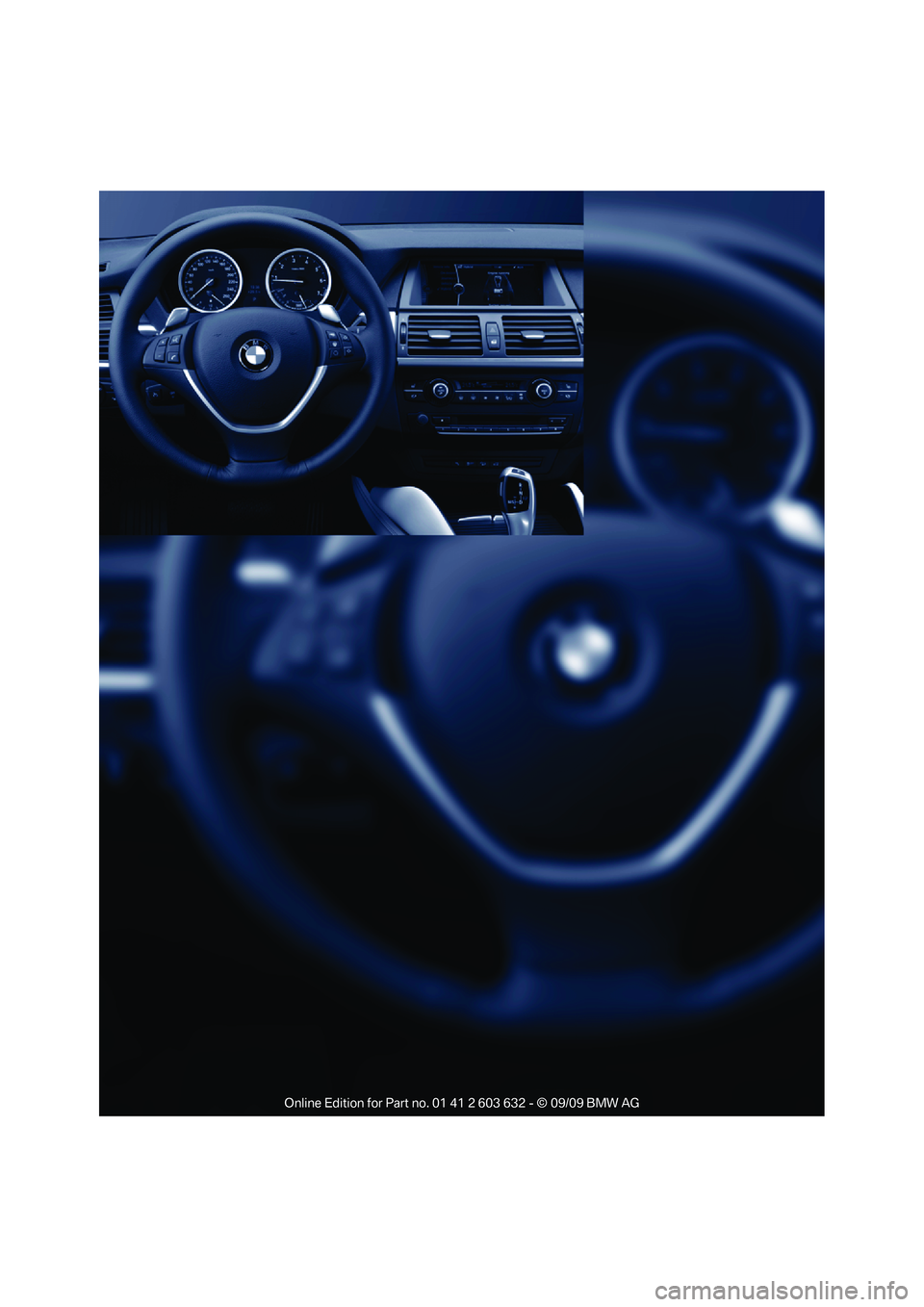
Page 13 of 54
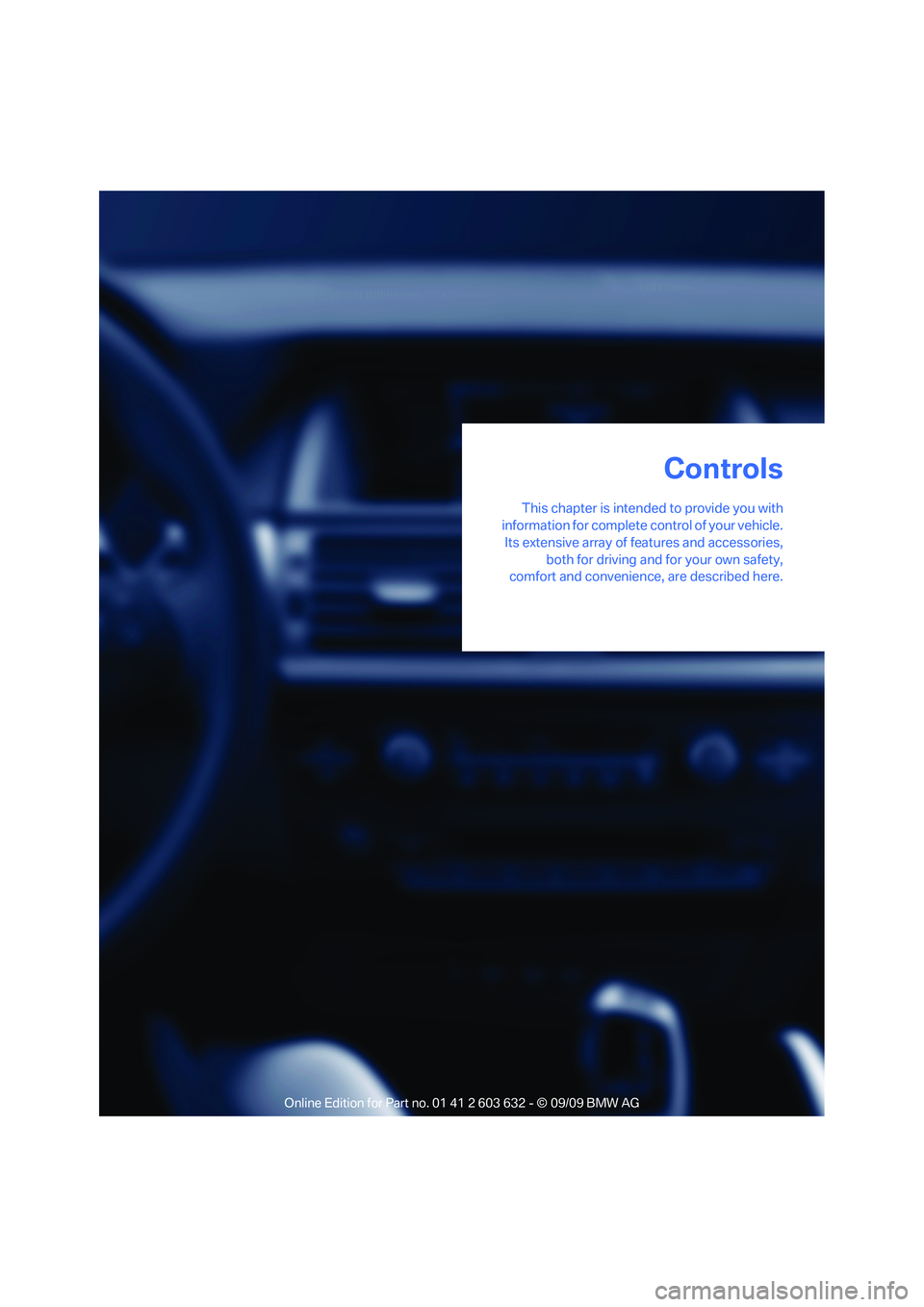
Controls
This chapter is intended to provide you with
information for complete control of your vehicle.
Its extensive array of features and accessories,
both for driving and for your own safety,
comfort and convenience, are described here.
Controls
Page 14 of 54
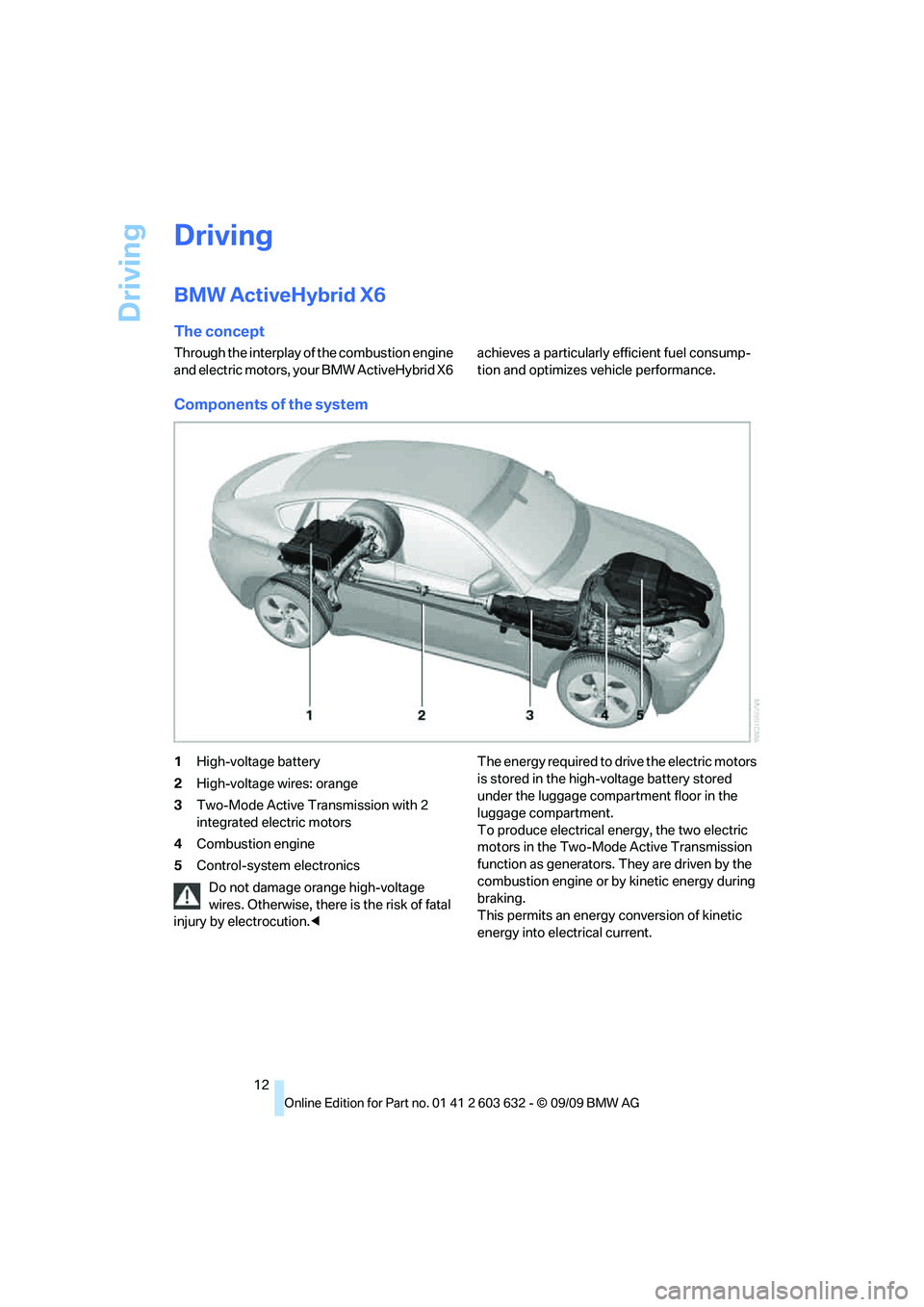
Driving
12
Driving
BMW ActiveHybrid X6
The concept
Through the interplay of the combustion engine
and electric motors, your BMW ActiveHybrid X6 achieves a particularly efficient fuel consump-
tion and optimizes vehicle performance.
Components of the system
1High-voltage battery
2High-voltage wires: orange
3Two-Mode Active Transmission with 2
integrated electric motors
4Combustion engine
5Control-system electronics
Do not damage orange high-voltage
wires. Otherwise, there is the risk of fatal
injury by electrocution.
under the luggage compartment floor in the
luggage compartment.
To produce electrical energy, the two electric
motors in the Two-Mode Active Transmission
function as generators. They are driven by the
combustion engine or by kinetic energy during
braking.
This permits an energy conversion of kinetic
energy into electrical current.
Page 15 of 54
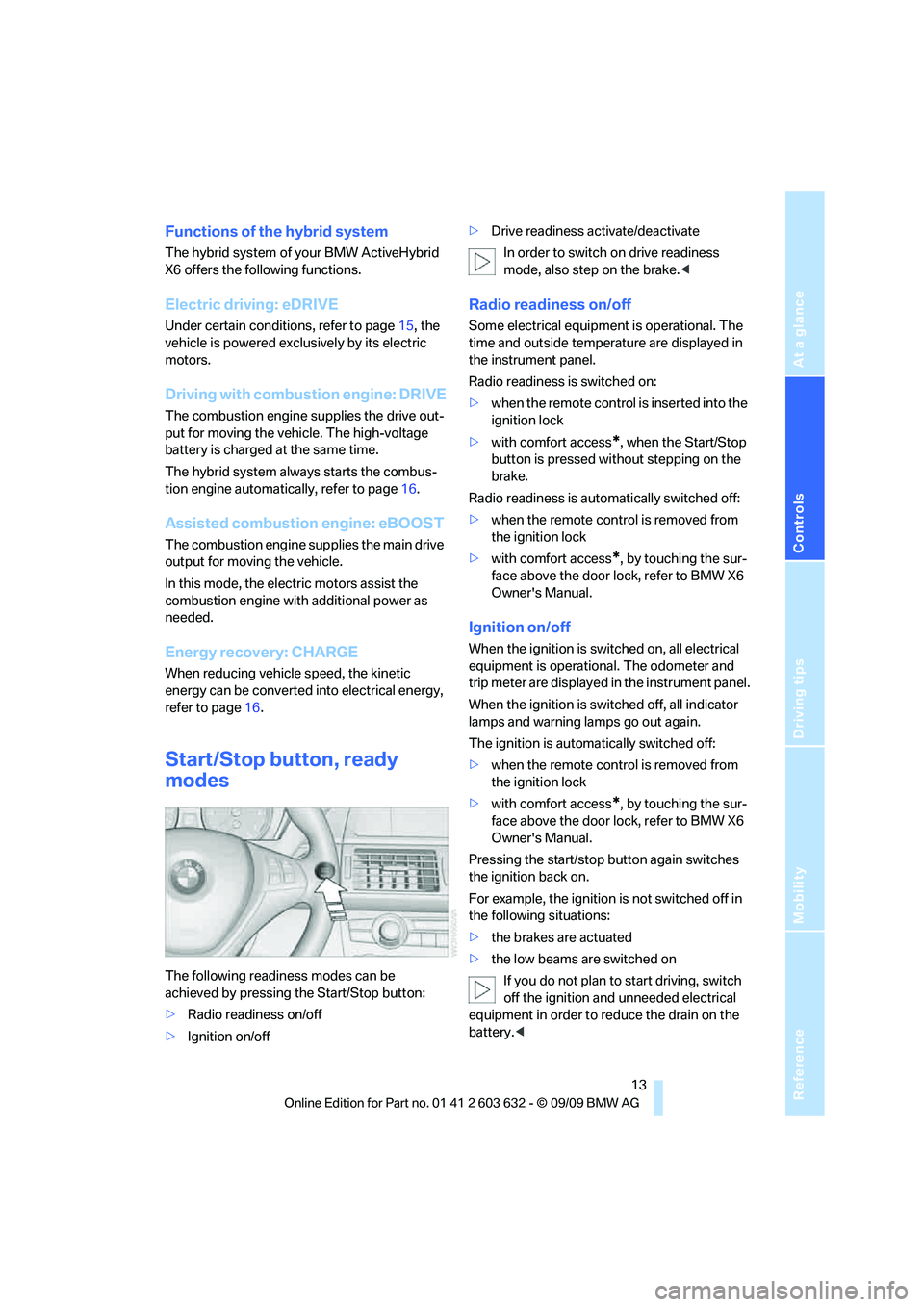
Reference
At a glance
Controls
Driving tips
Mobility
13
Functions of the hybrid system
The hybrid system of your BMW ActiveHybrid
X6 offers the following functions.
Electric driving: eDRIVE
Under certain conditions, refer to page15, the
vehicle is powered exclusively by its electric
motors.
Driving with combustion engine: DRIVE
The combustion engine supplies the drive out-
put for moving the vehicle. The high-voltage
battery is charged at the same time.
The hybrid system always starts the combus-
tion engine automatically, refer to page16.
Assisted combustion engine: eBOOST
The combustion engine supplies the main drive
output for moving the vehicle.
In this mode, the electric motors assist the
combustion engine with additional power as
needed.
Energy recovery: CHARGE
When reducing vehicle speed, the kinetic
energy can be converted into electrical energy,
refer to page16.
Start/Stop button, ready
modes
The following readiness modes can be
achieved by pressing the Start/Stop button:
>Radio readiness on/off
>Ignition on/off>Drive readiness activate/deactivate
In order to switch on drive readiness
mode, also step on the brake.<
Radio readiness on/off
Some electrical equipment is operational. The
time and outside temperature are displayed in
the instrument panel.
Radio readiness is switched on:
>when the remote control is inserted into the
ignition lock
>with comfort access
*, when the Start/Stop
button is pressed without stepping on the
brake.
Radio readiness is automatically switched off:
>when the remote control is removed from
the ignition lock
>with comfort access
*, by touching the sur-
face above the door lock, refer to BMW X6
Owner's Manual.
Ignition on/off
When the ignition is switched on, all electrical
equipment is operational. The odometer and
trip meter are displayed in the instrument panel.
When the ignition is switched off, all indicator
lamps and warning lamps go out again.
The ignition is automatically switched off:
>when the remote control is removed from
the ignition lock
>with comfort access
*, by touching the sur-
face above the door lock, refer to BMW X6
Owner's Manual.
Pressing the start/stop button again switches
the ignition back on.
For example, the ignition is not switched off in
the following situations:
>the brakes are actuated
>the low beams are switched on
If you do not plan to start driving, switch
off the ignition and unneeded electrical
equipment in order to reduce the drain on the
battery.<
Page 16 of 54
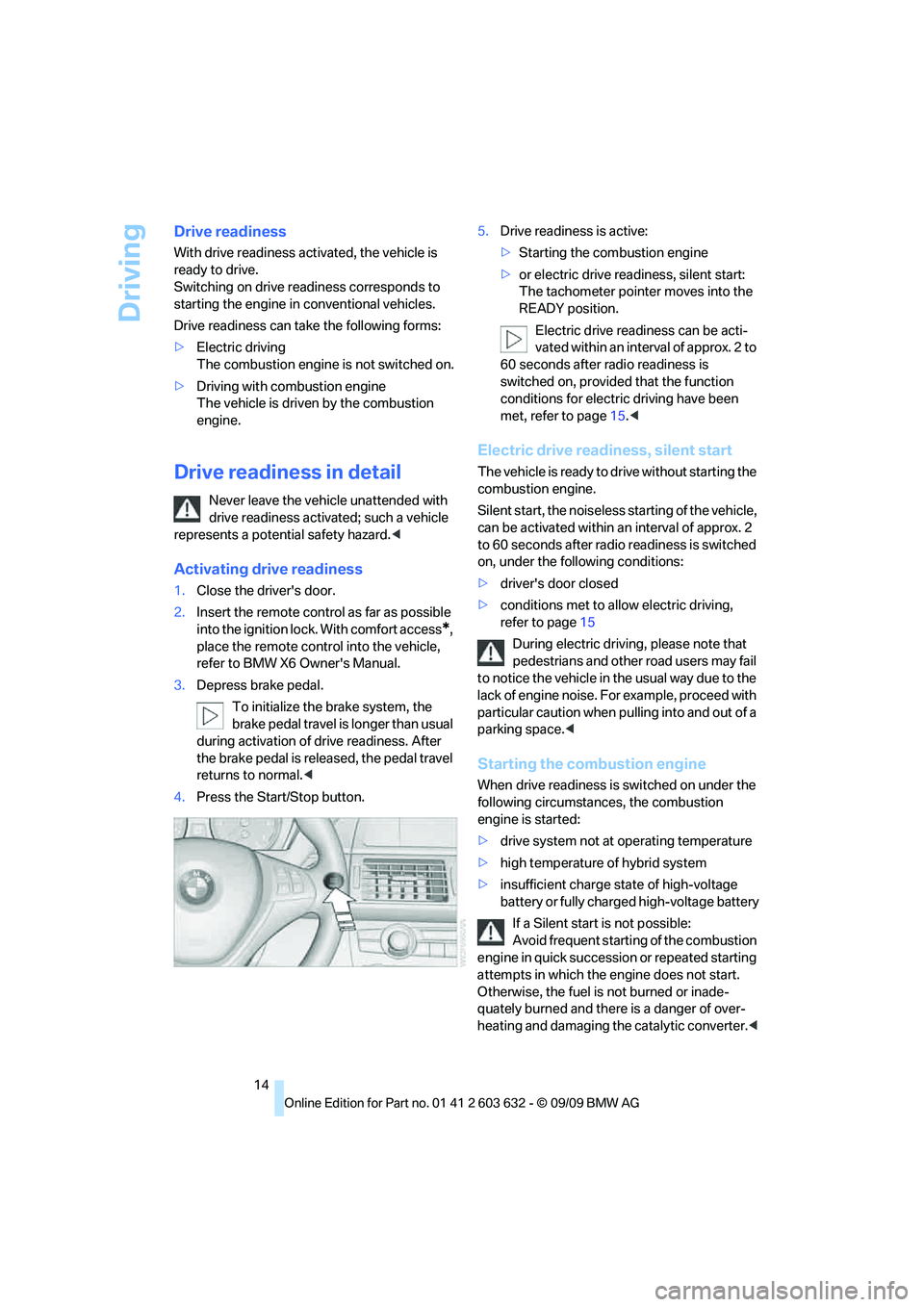
Driving
14
Drive readiness
With drive readiness activated, the vehicle is
ready to drive.
Switching on drive readiness corresponds to
starting the engine in conventional vehicles.
Drive readiness can take the following forms:
>Electric driving
The combustion engine is not switched on.
>Driving with combustion engine
The vehicle is driven by the combustion
engine.
Drive readiness in detail
Never leave the vehicle unattended with
drive readiness activated; such a vehicle
represents a potential safety hazard.<
Activating drive readiness
1.Close the driver's door.
2.Insert the remote control as far as possible
into the ignition lock. With comfort access
*,
place the remote control into the vehicle,
refer to BMW X6 Owner's Manual.
3.Depress brake pedal.
To initialize the brake system, the
brake pedal travel is longer than usual
during activation of drive readiness. After
the brake pedal is released, the pedal travel
returns to normal.<
4.Press the Start/Stop button.5.Drive readiness is active:
>Starting the combustion engine
>or electric drive readiness, silent start:
The tachometer pointer moves into the
READY position.
Electric drive readiness can be acti-
vated within an interval of approx. 2 to
60 seconds after radio readiness is
switched on, provided that the function
conditions for electric driving have been
met, refer to page15.<
Electric drive readiness, silent start
The vehicle is ready to drive without starting the
combustion engine.
Silent start, the noiseless starting of the vehicle,
can be activated within an interval of approx. 2
to 60 seconds after radio readiness is switched
on, under the following conditions:
>driver's door closed
>conditions met to allow electric driving,
refer to page15
During electric driving, please note that
pedestrians and other road users may fail
to notice the vehicle in the usual way due to the
lack of engine noise. For example, proceed with
particular caution when pulling into and out of a
parking space.<
Starting the combustion engine
When drive readiness is switched on under the
following circumstances, the combustion
engine is started:
>drive system not at operating temperature
>high temperature of hybrid system
>insufficient charge state of high-voltage
battery or fully charged high-voltage battery
If a Silent start is not possible:
Avoid frequent starting of the combustion
engine in quick succession or repeated starting
attempts in which the engine does not start.
Otherwise, the fuel is not burned or inade-
quately burned and there is a danger of over-
heating and damaging the catalytic converter.<
Page 17 of 54
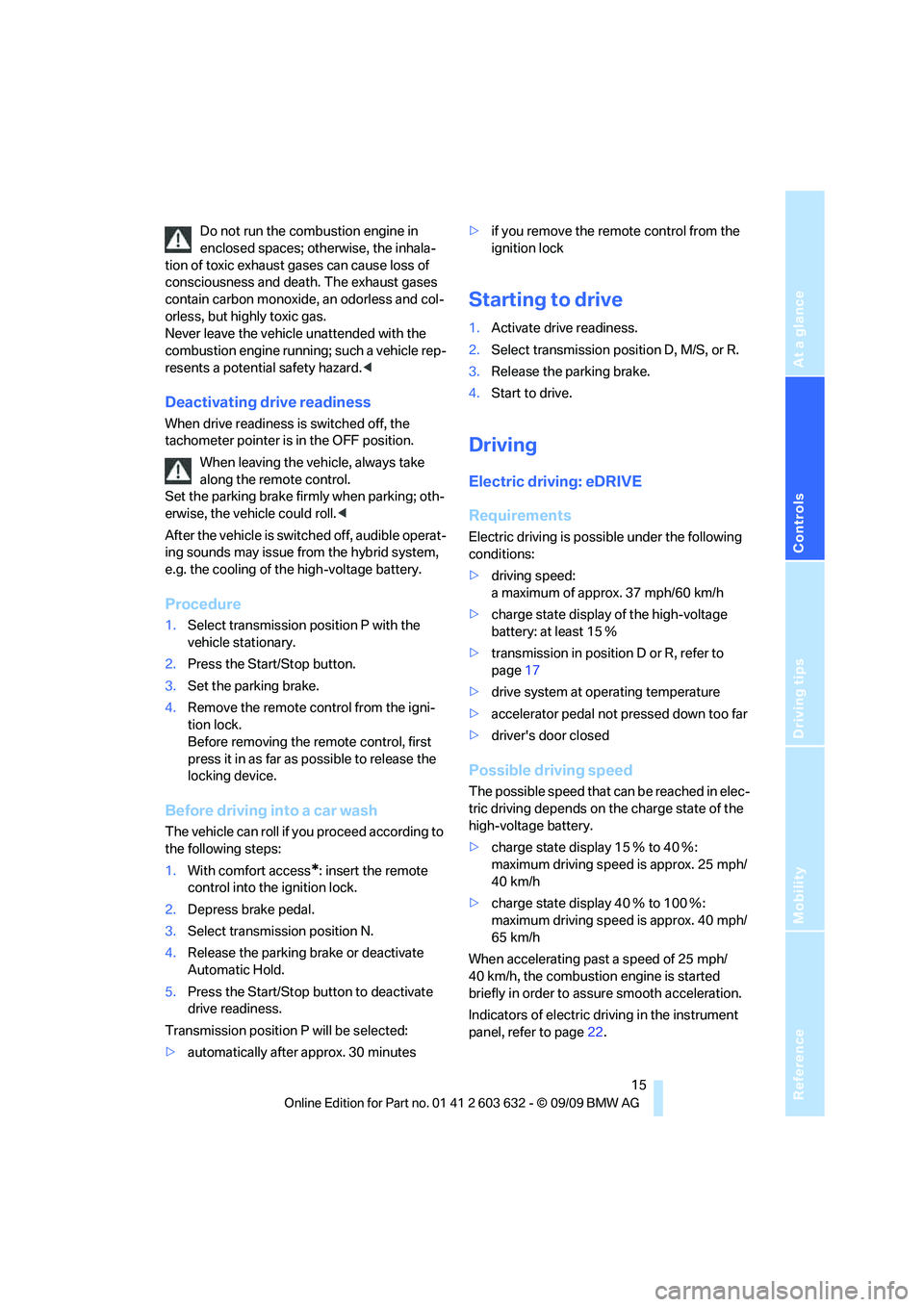
Reference
At a glance
Controls
Driving tips
Mobility
15
Do not run the combustion engine in
enclosed spaces; otherwise, the inhala-
tion of toxic exhaust gases can cause loss of
consciousness and death. The exhaust gases
contain carbon monoxide, an odorless and col-
orless, but highly toxic gas.
Never leave the vehicle unattended with the
combustion engine running; such a vehicle rep-
resents a potential safety hazard.<
Deactivating drive readiness
When drive readiness is switched off, the
tachometer pointer is in the OFF position.
When leaving the vehicle, always take
along the remote control.
Set the parking brake firmly when parking; oth-
erwise, the vehicle could roll.<
After the vehicle is switched off, audible operat-
ing sounds may issue from the hybrid system,
e.g. the cooling of the high-voltage battery.
Procedure
1.Select transmission position P with the
vehicle stationary.
2.Press the Start/Stop button.
3.Set the parking brake.
4.Remove the remote control from the igni-
tion lock.
Before removing the remote control, first
press it in as far as possible to release the
locking device.
Before driving into a car wash
The vehicle can roll if you proceed according to
the following steps:
1.With comfort access
*: insert the remote
control into the ignition lock.
2.Depress brake pedal.
3.Select transmission position N.
4.Release the parking brake or deactivate
Automatic Hold.
5.Press the Start/Stop button to deactivate
drive readiness.
Transmission position P will be selected:
>automatically after approx. 30 minutes>if you remove the remote control from the
ignition lock
Starting to drive
1.Activate drive readiness.
2.Select transmission position D, M/S, or R.
3.Release the parking brake.
4.Start to drive.
Driving
Electric driving: eDRIVE
Requirements
Electric driving is possible under the following
conditions:
>driving speed:
a maximum of approx. 37 mph/60 km/h
>charge state display of the high-voltage
battery: at least 15%
>transmission in position D or R, refer to
page17
>drive system at operating temperature
>accelerator pedal not pressed down too far
>driver's door closed
Possible driving speed
The possible speed that can be reached in elec-
tric driving depends on the charge state of the
high-voltage battery.
>charge state display 15% to 40%:
maximum driving speed is approx. 25 mph/
40 km/h
>charge state display 40% to 100%:
maximum driving speed is approx. 40 mph/
65 km/h
When accelerating past a speed of 25 mph/
40 km/h, the combustion engine is started
briefly in order to assure smooth acceleration.
Indicators of electric driving in the instrument
panel, refer to page22.
Page 18 of 54

Driving
16
Possible range
The vehicle can travel approx. 1.5 miles/2.5 km
under electric power.
Driving with combustion engine: DRIVE
The combustion engine supplies the drive out-
put for moving the vehicle. The high-voltage
battery is charged at the same time.
Automatic starting while driving
Under the following circumstances, the com-
bustion engine is started automatically while
driving:
>transmission position M/S selected
>driving speed greater than 40 mph/65 km/h
>low charge state or fully charged high-volt-
age battery, e.g. when driving downhill
>to protect the high-voltage system from
overheating, e.g. when driving downhill
>high output request, e.g. by accelerator
pedal position.
Automatic switching off while driving
When decelerating under the conditions for
electric driving, refer to page15, the combus-
tion engine is switched off.
Assisted combustion engine
The combustion engine supplies the main drive
output for moving the vehicle.
The electric motors assist by providing addi-
tional drive output as needed.
eBOOST
When accelerating quickly, e.g. when passing
another vehicle, power from the two electric
motors simultaneously is requested in addition
to that of the combustion engine. To trigger
this, step down hard on the accelerator pedal.
Display in the instrument panel, refer to
page22.
Energy recovery: CHARGE
The hybrid system makes it possible to convert
kinetic energy into electrical current, e.g. during braking. This energy recovery is used to charge
the high-voltage battery. The battery supplies
this stored energy back to the electric motors
as needed.
To recover the braking energy, the following
conditions must be met:
>The vehicle is in motion.
>The selector lever is in the position D, R, or
M/S.
>The high-voltage battery is not completely
charged.
Display of energy recovery in the instrument
panel, refer to page22
Two-Mode Active
Transmission with Steptronic
The Das Two-Mode Active Transmission is an
automatic transmission in which the gears can
be shifted in a fully automatic fashion or can be
shifted manually on demand. The manual shift-
ing is performed using the selector lever or the
shifting paddles of the Steptronic, refer to
page18.
Automatic shifting may be perceptible
when decelerating at a low speed.<
Transmission positions
P R N D M/S + –
Hold the brake pedal down until starting
to drive; otherwise, the vehicle can begin
to roll.<
Displays in instrument panel
P R N D, S1 through S7, M1 through M7
Page 19 of 54
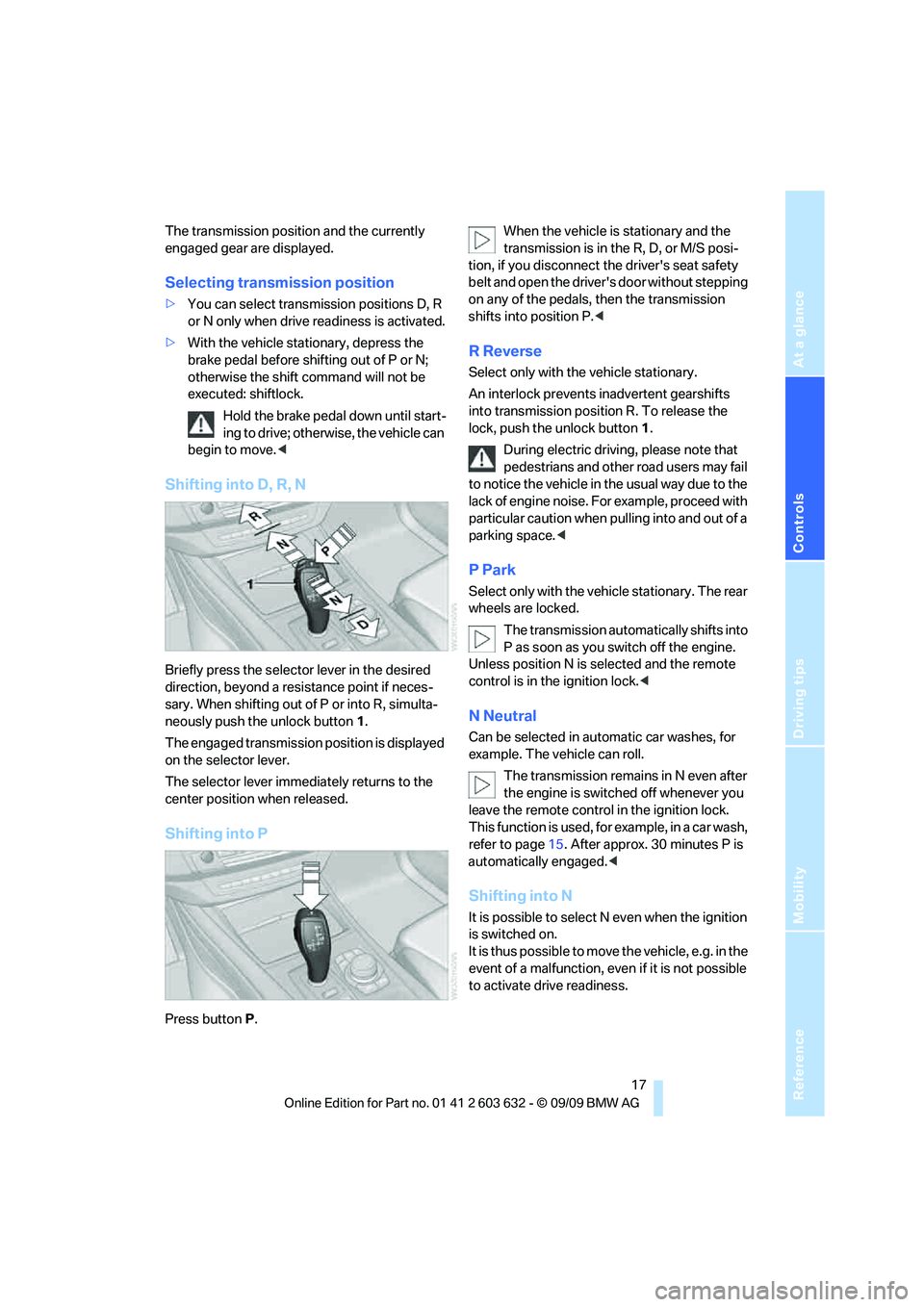
Reference
At a glance
Controls
Driving tips
Mobility
17
The transmission position and the currently
engaged gear are displayed.
Selecting transmission position
>You can select transmission positions D, R
or N only when drive readiness is activated.
>With the vehicle stationary, depress the
brake pedal before shifting out of P or N;
otherwise the shift command will not be
executed: shiftlock.
Hold the brake pedal down until start-
ing to drive; otherwise, the vehicle can
begin to move.<
Shifting into D, R, N
Briefly press the selector lever in the desired
direction, beyond a resistance point if neces-
sary. When shifting out of P or into R, simulta-
neously push the unlock button1.
The engaged transmission position is displayed
on the selector lever.
The selector lever immediately returns to the
center position when released.
Shifting into P
Press buttonP.When the vehicle is stationary and the
transmission is in the R, D, or M/S posi-
tion, if you disconnect the driver's seat safety
belt and open the driver's door without stepping
on any of the pedals, then the transmission
shifts into position P.<
R Reverse
Select only with the vehicle stationary.
An interlock prevents inadvertent gearshifts
into transmission position R. To release the
lock, push the unlock button1.
During electric driving, please note that
pedestrians and other road users may fail
to notice the vehicle in the usual way due to the
lack of engine noise. For example, proceed with
particular caution when pulling into and out of a
parking space.<
P Park
Select only with the vehicle stationary. The rear
wheels are locked.
The transmission automatically shifts into
P as soon as you switch off the engine.
Unless position N is selected and the remote
control is in the ignition lock.<
N Neutral
Can be selected in automatic car washes, for
example. The vehicle can roll.
The transmission remains in N even after
the engine is switched off whenever you
leave the remote control in the ignition lock.
This function is used, for example, in a car wash,
refer to page15. After approx. 30 minutes P is
automatically engaged.<
Shifting into N
It is possible to select N even when the ignition
is switched on.
I t i s t h u s p o s s i b l e t o m o v e t h e v e h i c l e , e . g . i n t h e
event of a malfunction, even if it is not possible
to activate drive readiness.
Page 20 of 54
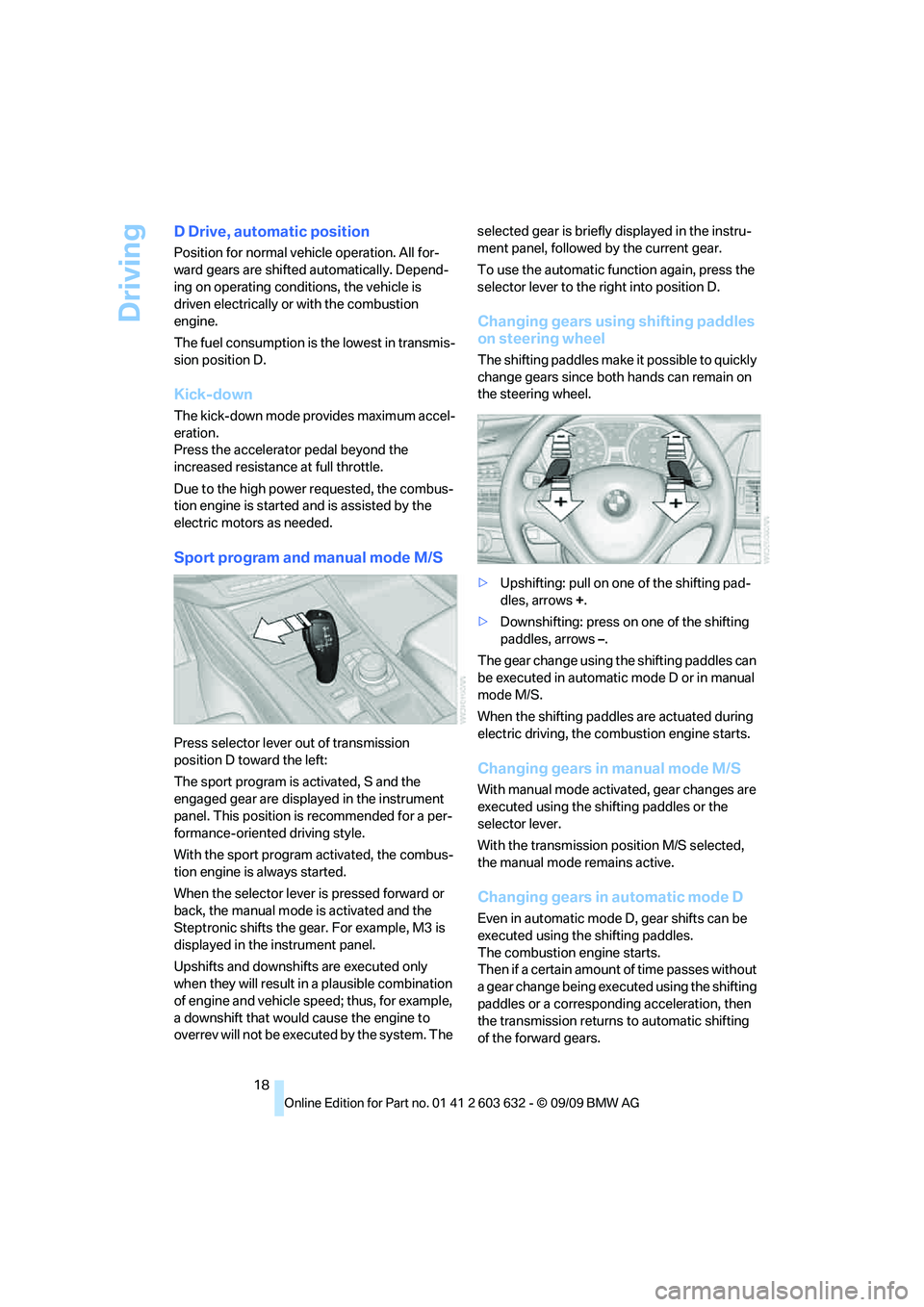
Driving
18
D Drive, automatic position
Position for normal vehicle operation. All for-
ward gears are shifted automatically. Depend-
ing on operating conditions, the vehicle is
driven electrically or with the combustion
engine.
The fuel consumption is the lowest in transmis-
sion position D.
Kick-down
The kick-down mode provides maximum accel-
eration.
Press the accelerator pedal beyond the
increased resistance at full throttle.
Due to the high power requested, the combus-
tion engine is started and is assisted by the
electric motors as needed.
Sport program and manual mode M/S
Press selector lever out of transmission
position D toward the left:
The sport program is activated, S and the
engaged gear are displayed in the instrument
panel. This position is recommended for a per-
formance-oriented driving style.
With the sport program activated, the combus-
tion engine is always started.
When the selector lever is pressed forward or
back, the manual mode is activated and the
Steptronic shifts the gear. For example, M3 is
displayed in the instrument panel.
Upshifts and downshifts are executed only
when they will result in a plausible combination
of engine and vehicle speed; thus, for example,
a downshift that would cause the engine to
overrev will not be executed by the system. The selected gear is briefly displayed in the instru-
ment panel, followed by the current gear.
To use the automatic function again, press the
selector lever to the right into position D.
Changing gears using shifting paddles
on steering wheel
The shifting paddles make it possible to quickly
change gears since both hands can remain on
the steering wheel.
>Upshifting: pull on one of the shifting pad-
dles, arrows +.
>Downshifting: press on one of the shifting
paddles, arrows –.
The gear change using the shifting paddles can
be executed in automatic mode D or in manual
mode M/S.
When the shifting paddles are actuated during
electric driving, the combustion engine starts.
Changing gears in manual mode M/S
With manual mode activated, gear changes are
executed using the shifting paddles or the
selector lever.
With the transmission position M/S selected,
the manual mode remains active.
Changing gears in automatic mode D
Even in automatic mode D, gear shifts can be
executed using the shifting paddles.
The combustion engine starts.
Then if a certa in amount of time pas ses witho ut
a gear change being executed using the shifting
paddles or a corresponding acceleration, then
the transmission returns to automatic shifting
of the forward gears.